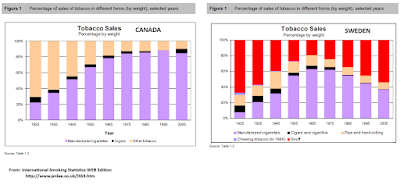This post responds to recurring efforts by tobacco companies and their allies to promote the "Swedish Experience" as template for harm reduction based on oral nicotine delivery.
Data from reliable sources are used fact check the industry's claims. They show that for most indicators Sweden has not out-performed Canada with respect to reducing smoking prevalence or reducing tobacco-related disease. The Swedish experience is one where twice as many people use nicotine... and smoking is not being phased out more quickly.
Pouch promoters say Sweden is a tobacco control success story
Tobacco companies promote Sweden's permissive approach to snus as a way to keep smokers happy (with nicotine), keep investors happy (with high sales and profits) and keep health regulators happy (with low levels of disease).
 |
| From BAT Presentation, 2024 |
Examples of this sales pitch can be found in investor presentations (such as those earlier this spring by British American Tobacco and Philip Morris International), in messaging from allied agencies (such as Smokefree Sweden), in industry-friendly media and on social media.
- Estimates of smoking rates in Sweden are generally not lower than those in Canada.
- Smoking rates in Sweden have fallen, but not at a faster rate than in Canada
- Twice as many Swedes use tobacco-industry nicotine products as do Canadians (30% vs 15%).
- Lung cancer death rates among men are lower in Sweden than Canada, but the situation for other major tobacco-related diseases is not better.
- Tobacco-related deaths have fallen faster in Canada than in Sweden
- Sweden's lower lung cancer rates are rooted in lower tobacco use in the last century (not an outcome of current snus use)
For decades, the OECD has tracked daily smoking rates among men and women in its high-income member states. The OCED provides access to this data, and also presents it in data visualizations.
OECD Countries identified as having lower daily cigarette smoking rates in 2021 than Sweden (9.7%) include New Zealand (9.4%), the United States (8.8%), Canada (8.7%), Mexico (8.6%), Norway (8%), Costa Rica (7.8%) and Iceland (7%). The World Health Organizations' report on tobacco smoking rates similarly shows Sweden behind Canada (12.6% vs 12%, Table A1.2), although rates of smoking manufactured cigarettes are slightly higher in Canada (where roll-your-own tobacco is no longer common).
Smoking rates in Sweden have fallen, but not at a faster rate than in Canada
The Global Burden of Disease group and the Institute for Health Metrics and Evaluation provide historic smoking prevalence data which has been age-standardized to allow comparisons among countries and across time periods.(The data are available here).
Their data shows that Sweden has done well (ranking 12th among 204 countries) - but that other countries, including Canada (ranked 9th) and Australia (ranked 7th) have done better. The country with the greatest progress was Brazil, where the rate of oral tobacco use is very low and e-cigarettes are not legal for sale.
Twice as many Swedes use tobacco-industry nicotine products as do Canadians
There are 4 main categories of nicotine products sold by tobacco companies: cigarettes and cigarette tobacco, electronic cigarettes/vaping products, heated tobacco products and nicotine pouches.
There are currently no global databases with information on the overall use of nicotine through these products, but national surveys can be used for this purpose.
- Information for Sweden in 2022 can be found in a report on the use of cigarettes, snus and e-cigarettes among Swedes produced by the Swedish Council for Information on Alcohol and Other Drugs. The report uses a representative survey of 18,000 Swedes aged 17 to 84 and identifies past-month use of these products. Sweden's health authorities do not report on heated tobacco use, suggesting that its use is perceived to be very low.
- Information for Canada in 2022 can be found in the Canadian Tobacco and Nicotine Survey,(CTNS), which surveyed 12,000 Canadians who were older than 15. This survey asked about several forms of tobacco use, but did not inquire about heated tobacco products, suggesting that the use of this product category is perceived to be very low.
Results from these two surveys show similar rates for past month use of cigarettes (12% in Sweden, 11% in Canada), and not very different rates for vaping (4% in Sweden to 6% in Canada). One in 5 Swedes used either snus or non-tobacco nicotine pouches (20%) compared with fewer than 1% of Canadians. Because of snus use, twice as many Swedes use nicotine as do Canadians (30% vs. 15%).
(A data sheet with the information presented below as well as for men and women can be downloaded here).
Lung cancer rates among men are lower in Sweden than in Canada, but the situation for other major tobacco-related diseases is no better.
The World Health Organization provides information on the number and rate of deaths from specific diseases, and also provides data files which make age-adjustments to this data to allow for comparison between countries.Using only countries for which WHO signals the data is robust enough for comparison, Sweden is in the second-best quintile for overall deaths from lung cancer and Canada is in the worst.
For lung cancer rates among men, Sweden is in the second-best quintile for men, but in the second-worst for women. Canada is in the middle quintile for men but the worst for women.
The 20 countries for which comparable data is available and which have lower age-standardized lung-cancer rates than Sweden for the whole population are (in decreasing order): Jamaica, Venezuela, Kyrgyzstan, Philippines, Brazil, Chile, Trinidad-Tobacco, Belize, Grenada, Mauritius, Colombia, Saint Lucia, Barbados, Kuwait, Panama, Mexico, Antigua-Barbuda, Nicaragua, St Vincent and the Grenadines and Costa Rica.
(A data sheet with lung cancer rates extracted from WHO's files can be downloaded here).
 |
| Grams of tobacco consumed per day per adult. From P.N. Lee, International Smoking Statistics for Sweden and Canada |







